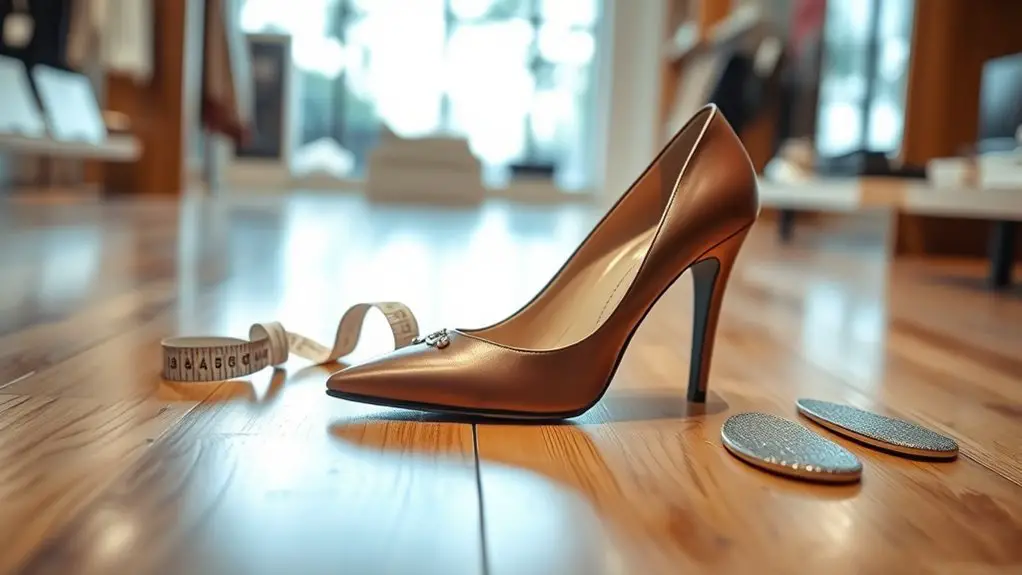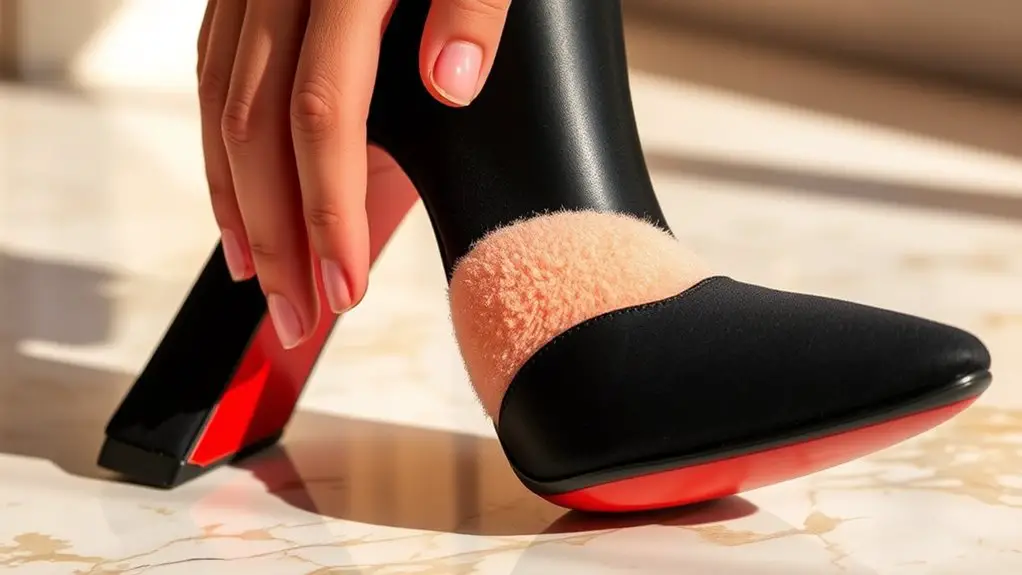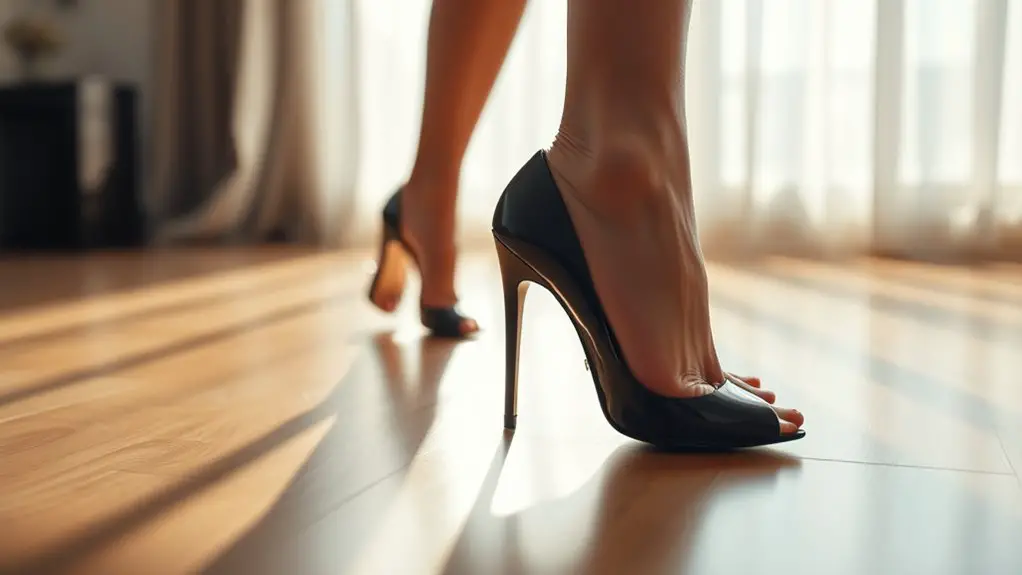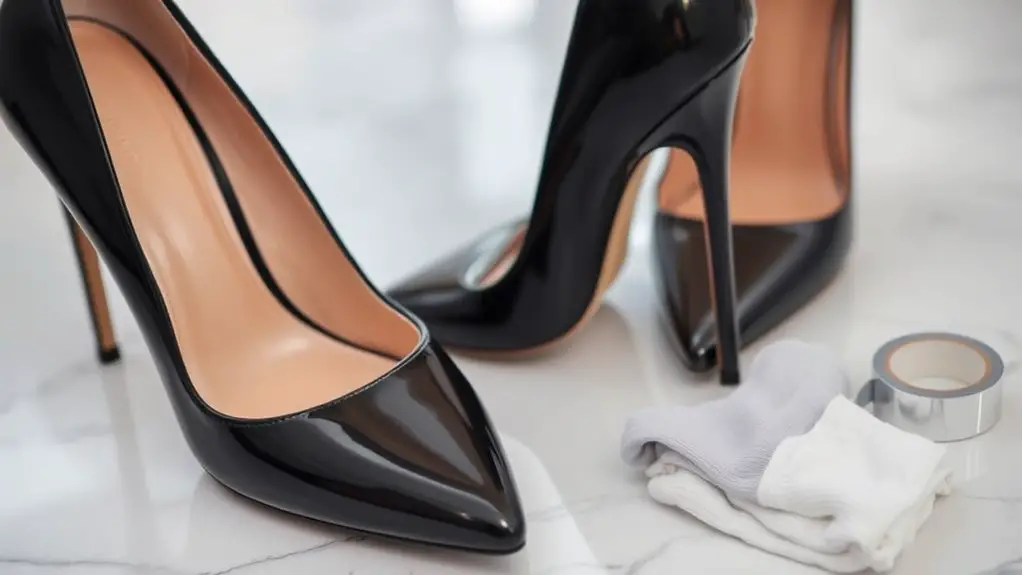To stop your feet from sliding forward in heels, choose the right size and fit by measuring your feet regularly. Opt for heels with a higher back for better ankle support and stability. Consider using non-slip insoles, along with heel grips or cushions, to improve comfort. Avoid overly slippery materials in shoe construction. Finally, practice proper walking techniques to enhance balance. There’s more to explore on ensuring your heels provide the comfort and support you need.
Choose the Right Size and Fit

When it comes to preventing your feet from sliding forward in heels, choosing the right size and fit is essential. Start by taking accurate foot measurements, as this will help you identify your true size. Many people wear the wrong size, which can lead to discomfort and instability in heels. Remember that foot size can change over time, so it’s wise to measure your feet regularly.
Once you have your measurements, look for brands that offer proper sizing. Different brands can vary greatly in their fit, so don’t hesitate to try on multiple sizes and styles. Pay attention to how your heels feel; they should hug your feet without pinching or leaving excess space. A snug fit around the heel and midfoot can minimize sliding, ensuring you stay comfortable and stable throughout the day. Prioritizing a proper fit is a key step in enjoying your heels without the hassle of slipping.
Opt for Heels With a Higher Back
Choosing heels with a higher back can greatly enhance ankle support, which is essential for preventing your feet from sliding forward. These styles not only improve stability and comfort but also come in a variety of stylish designs to suit your wardrobe. By making this simple switch, you’ll enjoy a more secure fit without sacrificing fashion.
Enhanced Ankle Support
To guarantee your feet stay secure in heels, opting for styles with a higher back can make a significant difference. Higher backs provide enhanced ankle support, helping to keep your feet in place and reducing the risk of sliding forward. When selecting your heels, consider the following:
- Look for ankle braces built into the design for added stability.
- Choose styles with supportive straps that wrap around the ankle for a snug fit.
- Ascertain the heel height is manageable to prevent excessive forward pressure.
Improved Stability and Comfort
Opt for heels with a higher back to greatly enhance your stability and comfort. This design aligns better with your foot anatomy, providing essential support that minimizes sliding. A higher back can help distribute your weight more evenly, which is especially important when considering heel height.
Here’s a quick comparison of various heel heights and their stability:
| Heel Height | Stability Level | Comfort Level | Ideal For | Considerations |
|---|---|---|---|---|
| 1-2 inches | High | Very High | Daily Wear | Easy to walk in |
| 2-3 inches | Moderate | Moderate | Office | Balance needed |
| 3-4 inches | Low | Moderate | Events | Practice required |
| 4+ inches | Very Low | Low | Special Occasions | Risk of sliding |
| Wedges | High | High | Casual | Good for walking |
Choosing wisely can make all the difference in your comfort.
Stylish Design Options
Many stylish heels now feature a higher back, blending fashion with functionality. This design not only elevates your look but also helps keep your feet securely in place. When choosing your next pair, consider these fashionable heel types:
- Chunky heels: Offer stability while still looking chic.
- Ankle strap heels: Keep your foot anchored, especially with chic strap designs.
- Platform heels: Provide added height without sacrificing comfort.
Use Non-Slip Insoles
Non-slip insoles can be a game changer when it comes to preventing your feet from sliding forward in heels. These insoles often incorporate non-slip materials that create friction against the shoe’s interior, effectively holding your foot in place. This added grip not only enhances comfort but also reduces the risk of blisters and pain from excessive movement.
One of the significant insole benefits is their ability to cushion your feet, providing support where you need it most. They can also help distribute pressure more evenly, reducing strain on your toes and the balls of your feet. When choosing non-slip insoles, look for those specifically designed for high heels, as they often come with arch support and a snug fit. By investing in quality non-slip insoles, you’ll enjoy a more stable and comfortable experience, allowing you to wear your favorite heels with confidence.
Try Heel Grips or Cushions

Heel grips or cushions can greatly improve your comfort when wearing high heels. They help prevent your feet from sliding forward, providing extra support and stability. There are several heel grip types to choose from, each designed to enhance your shoe experience:
Heel grips enhance comfort in high heels by preventing foot slippage and providing essential support and stability.
- Gel grips: Made from soft silicone, they offer a comfortable cushion that molds to your heel.
- Foam cushions: These are lightweight and provide a plush feel, helping to absorb shock as you walk.
- Leather grips: Durable and breathable, they can add a touch of luxury while reducing slippage.
When selecting the right cushion materials, consider your personal comfort preferences and the type of shoes you wear. By incorporating heel grips or cushions, you’ll find that your heels become more enjoyable to wear, allowing you to focus on looking stylish without the discomfort.
Avoid Overly Slippery Materials
When choosing heels, pay attention to the materials used in both the soles and the upper. Opt for textured soles that provide grip and select non-slip fabrics to keep your feet securely in place. This simple change can make a significant difference in your comfort and stability while wearing heels.
Choose Textured Soles
Choosing the right sole can make a significant difference in your comfort and stability while wearing heels. Opt for textured soles that provide better traction, preventing your feet from sliding forward. Textured traction enhances surface grip, allowing you to walk confidently without the fear of losing your footing. Here are some key features to look for:
- Rubber soles: They offer excellent grip and durability.
- Embossed patterns: These add extra texture for improved traction.
- Wedge or block heels: They distribute weight more evenly, enhancing stability.
Opt for Non-Slip Fabrics
To maintain stability in heels, opting for non-slip fabrics can greatly enhance your comfort. When selecting shoes, pay attention to fabric types that provide grip. Look for non-slip materials like suede, textured leather, or specialized synthetics designed to reduce slippage. These fabrics create friction against your foot, preventing it from sliding forward. Avoid overly slippery materials such as satin or glossy finishes, which can exacerbate the problem. Additionally, consider shoes with linings made from breathable non-slip fabrics, as they can help anchor your feet in place. By prioritizing the right fabric types, you’ll not only boost your stability but also improve your overall wearing experience. Embrace the comfort that comes with informed choices in footwear.
Practice Walking Techniques

Mastering your walking technique in heels can considerably reduce foot slippage and enhance your overall comfort. To achieve this, focus on maintaining good posture awareness and practicing balance exercises. Here are some effective techniques to incorporate into your routine:
- Engage your core: Strengthening your core muscles helps stabilize your body, providing better balance while walking in heels.
- Take smaller steps: Shorter strides reduce the risk of losing your balance and help keep your feet secure in your shoes.
- Shift your weight: Distributing your weight evenly across your feet allows for greater control and less slippage.
Regularly practicing these techniques will not only improve your confidence in heels but also minimize discomfort. Remember, the more you focus on your posture and balance, the more comfortable you’ll feel, allowing you to strut your stuff without the worry of sliding forward.
Frequently Asked Questions
Can I Wear Heels if I Have Wide Feet?
Yes, you can wear heels with wide feet by exploring wide foot options. Look for styles specifically designed for broader heel width considerations, ensuring comfort and stability without compromising your style. Always prioritize fit over fashion!
How Often Should I Replace My Insoles?
Think of insoles as the unsung heroes of your shoes. You should replace them every 6 to 12 months, depending on insole materials and usage. Regular replacements guarantee comfort and support, keeping your feet happy.
Are There Specific Brands Known for Better Heel Support?
When searching for better heel support, consider brands like Dr. Scholl’s, Powerstep, and Superfeet. They’re known for their cushioning and stability, which can greatly enhance your comfort while wearing heels.
Does the Height of the Heel Impact Foot Sliding?
You might’ve noticed that heel height considerably impacts foot comfort. Taller heels often create more forward pressure, leading to sliding. Opting for lower heels can enhance stability, reducing the likelihood of your feet shifting inside.
What Exercises Can Strengthen My Feet for Better Stability?
To strengthen your feet for better stability, incorporate exercises like toe stretches for foot flexibility and balance training activities, such as single-leg stands. These practices enhance strength, coordination, and overall foot stability, improving your confidence.



